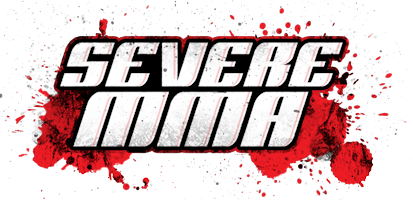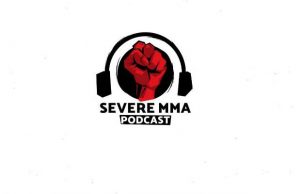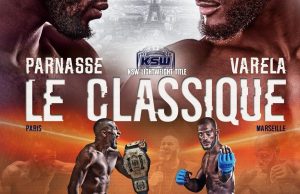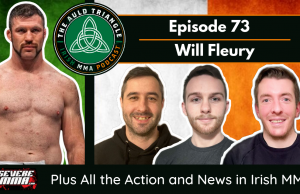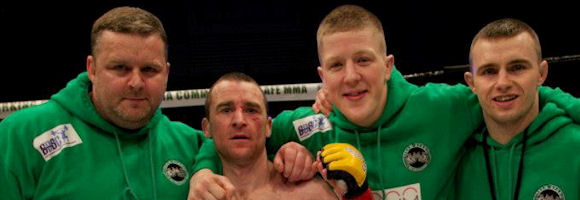

In the third instalment of Foundations, PETER CARROLL spoke to one of the most celebrated personalities in Irish MMA, Andy Ryan. The Team Ryano boss discussed his introduction to martial arts, being a full time judoka, his transition to MMA, the beginnings of Team Ryano, early competition in Ireland and some of the major milestones in his club’s history.
A coach, competitor, promoter and match-maker – there aren’t many people in the world that can say they know more about mixed martial arts than Andy Ryan. One of the most important men when it comes to the development of MMA in Ireland, the international spotlight finally fell on the Dubliner last year when Neil Seery won the team’s first world championship at Cage Warriors in Dublin.
Ryan has long been known for his mastery of the grappling arts within the Irish MMA community. A black belt in judo and jiu jitsu, the Team Ryano head coach explained how his introduction to his first love, judo, came about by accident.
“I actually joined a judo club thinking it was a karate club as a young kid in the 70s,” Ryan revealed. “At the time Bruce Lee films, Kung-Fu and Monkey Magic were on TV and I wanted to join to be like them.
“I ended up going down to this club called the Daigokan in Killester where they did Kenpo karate, judo and aikido. I just happened to go down on the judo night and I loved it.”
In his fledgling years Ryan showed an interested in cross-training, little did he know that a sport born out of the same philosophy would become his career in later life. Although he dabbled in other disciplines, he highlighted how he always found himself going back to judo.
“I boxed as well for a bit with Trinity Boys, I did a bit of Kenpo and other stuff but judo was the main thing for me,” he said.
A goliath of man, it’s hard to believe that Ryan ever had trouble holding his own on the mats, but he revealed how he struggled for years when he first began training albeit against bigger and older opponents.
Ryan said: “I got battered for the first six years in judo training. I was never one of the kids that won. It was probably four years of training before I won my first competition. It wasn’t ’til I was about 12 or 13 that I started winning, you know, properly.
“I think I was at an awkward age. From the age of six to 10 I was training with guys that were older than me. I was always in the youngest end of it until I was about 12 and by then I had matured a bit.
“Because I had been beaten so often from a young age that when I turned 12, I was that little bit stronger and tougher than the lads I’d be up against.”
Training judo on a full-time basis as he advanced in years, Ryan outlined his regime and spoke of how his introduction to Norman Coprani changed the way he looked at conditioning for competition.
“I trained with a guy called Norman Coprani. He wouldn’t have been a big international player himself, but he was a very good manager and he taught judo to the blind and things like that. He was one of the managers on the scene for the Irish judo team.
“He always had me running and he had me in the Hercules Gym. I was wrestling and weight lifting. He would’ve been big into his cross training. A typical week for me would’ve been, Monday and Thursday in Portmarknock judo club, Tuesday in Coolmine judo club and Saturday would be Pamlerstown judo club.
“On top of that I’d be in the Hercules or Flex Gym doing my weights. I’d go down to the ALSAA then on Wednesday and Saturday to do some running on the track. It was a full time thing for me.”
Ryan brought to light his first steps in the MMA world, which he accessed through the father of one of Team Ryano’s best-known products, John Donnelly.
“Peter Donnelly, John Donnelly’s father, a lot of people wouldn’t know him, he was one of the first guys doing MMA from the middle to the late 90’s. We used to meet up in a gym, I was still doing the judo and he had gone over to train with John Kavanagh.
“I had a gym at the time, it was around ’98, and we had some mad name on it like Horizon Martial Arts – I think John Donnelly still has one of the t-shirts. We used to do a little bit back then. John Kavanagh used to come over to me and I’d go over to him.
“I was in Killester at the time, we’d train twice a week and John was in St Andrews College. I’d go over to him Saturday morning and he’d come over to me on Saturday afternoon.
“But it was Peter Donnelly that gave me an introduction to the sport, I’d seen a few videos as well like the early UFCs and the Brazilian Vale Tudo ones. We used to piss about doing stuff that we’d seen on them videos when we came home at the weekend.
“It wasn’t until I retired from the judo that I jumped ship to MMA, I had a couple of injuries in 2000 and I knew I wasn’t going to make the Olympics. It just killed my drive and that was the end of it.”
As the two teams continued to train together, it wasn’t long before their competitive requirements needed to be met and the first MMA tournaments in Northern Ireland provided the practitioners from the south with that platform.
“We started heading up North for competition and the way it was you’d just show up, the mats would be down and that was that. Lee Hasdell had come over from England and Tom LaMont, they were pushing MMA at the time.
“The rules would be all over the place, some fights would be Vale Tudo and then some would be like Pancrase where you couldn’t strike with a closed fist. You’d only find out who you were fighting on the day.
“It’d be like ‘you stand beside him, yeah you’re the same height” or “you two are in around the same size”, and that’s how matches were made. There was no bitching or anything like that.
“Nobody really cared if they won or lost. I won three fights in one day all wearing my judo suit once, I felt great.
“Paddy Mooney used to run some events up there too and we’d go up to the Europa Hotel or the Balmoral Hotel. There was no bullshit, everyone would weigh in and then get matched up. It was no big deal, it was all amateur.
“Greg Loughran lost five or six fights in a row up there and he ended up being one of the best fighters to come out of the country. We were all just trying to learn, it was all about the sport,” Ryan affirmed.
Reminiscing on the early Irish amateur shows, Ryan spoke about how he believes that the current amateur scene does not promote the values of the sport that it should be.
“The way that the amateur sport is going at the moment, it’s killing MMA in Ireland,” he said. “I’ve always been involved with shows, even as far back as the Ring of Truth with John Kavanagh and then Cage of Truth.
“We ran the Cage Rage ones here too and I’m involved with Cage Warriors now. We own shows ourselves but I find that amateurs now are a lot more difficult. We’d ring looking for fighters and some of the coaches want video on their opponents and they want things like petrol money. I saw John talking about them having banners and stuff, he’s right about that, it’s mad.
“This is amateur. Relax and enjoy it, stop putting pressure on yourselves. I don’t mind, I’d knock all the shows on the head and go back to the sports hall. It should be like the kickboxing or jiu jitsu competitions – just get out there and compete.
“It should be like a competition. The fighters should be saying ‘I won my first two and then I lost in the final’, but I talk to lads and they’re telling me they’re 5-3. That type of stuff has no place in the amateur sport.”
Ryan commented on the first full-time MMA gym he opened, SBG Northside, an affiliate of John Kavanagh’s.
“Originally I was just running the gym on and off because I was kind of looking after Portmarknock judo club with Ray Stears at the same time. Willie Hanlon was running a gym in Finglas, Euphoria Gym, and in 2005 we went full time there, it was SBG Northside at the time.
“John was always pushing me to open a full time gym, because I used to help him with a little bit of coaching over in his place.”
Not long after the establishment of SBG Northside the two coaches went their own ways, Ryan highlighted why he felt he had to separate from the SBG banner and how he has remained friends with John Kavanagh.
“John was going one road and I was going the other, so I felt at the time it was better for my guys to break away. Competitions would come up and between my lads and John’s we wouldn’t know who to send, so I just felt it would work better if me and the lads stood on our own.
“I was going down a different route with the jiu jitsu than John was too. I did a lot of training with Rodrigo Medeiros and I liked the way they were set up. It reminded me of judo they were very old school – line up and bow – that sort of stuff.
“I just had a chat with John and told him I was going my own way and he had no problem with that. We’re still good friends, we still train together so it was no big deal. There were so little of us involved then it probably worked out for the better. Even when we were SBG Northside we were fighting the other SBG lads,” Ryan revealed.
One of the earlier problems for Ryan was delegating coaching to others rather than taking everything on himself. After a chat with Limerick jiu jitsu ace Fergal Quinlan, he learned that he needed to take a few steps back.
“It was hard for me because I would be training with one team and then neglecting the other. It wasn’t until I was talking to Fergal Quinlan that I changed things. He’s a great jiu jitsu player and a great friend of mine and he was winning Pan-Am medals as far back as 2005, before the new Irish jiu jitsu stars.
“He asked me one day what classes I taught and I told him, ‘I do Monday morning and I do four classes Monday evening’, and he stopped me there, he thought I was crazy.
“We’ve worked on that and now we’ve got John Donnelly, Neil Seery, Robbie Brennan and Paul Redmond taking some classes. Stephen O’Toole and Dave McConkey take care of some of the day classes as well, so it’s much easier for me now.”
Ryan recalled some of the significant moments in the early Ryano days:
“Dave Jones had a submission tournament and we ended up winning it just as we were going out on our own, that was the last competition we had as SBG Northside. The team was Liam and Stephen O’Toole and TJ Davitt and we always had a good few judo players and decent grapplers that were coming and going, there was a few of them at that as well.
“We didn’t have much going on the pro scene but we always had guys competing at amateur like Karl Roche and we’ve had a good few foreign guys over the years that had been competing and training from the gym. They would finish and then a new crop of lads would come along.
“When we moved from the big Baldoyle gym to Kilbarrack, that’s when we got a little bit more serious. We were working with Baldoyle boxing club and that seemed to bring us on a lot.”
The Ryano head coach highlighted that only when his first professionals – Eric Boylan, Patrick Boylan, Richie Edgeworth and Neil Seery – started to travel abroad to compete did they begin to believe in themselves.
His insights also acknowledge the great interclub respect and friendships that exists in Ireland with all of the island’s fighters coming together when they found themselves across the water at the same time.
“I found that we moved onto the next level when we start travelling over to shows in the UK, the likes of Strike and Submit. Rodney Moore would be there with his lads and SBG would be there. We’d get together and we’d find a dressing room and put a sticker on the door, that would ours for the night.
“We used to hit the Extreme Brawl shows too, and it was around then that I started to see the lads take big leaps in the sport.
“We all knew that we had to go and compete in England. We must’ve done ten Strike and Submit shows over there, we did the Extreme Brawl a few times and we did shows in Scotland in the arsehole of nowhere. It was all about getting the lads away for the weekend, getting them competing, building the team atmosphere and meeting new faces.
“I found that because the lads were mixing it up with lads from different countries it kind of made some of them think that they could really make a go of it. Getting out of Ireland was very important,” said Ryan.
Speaking about the bigger professional shows that Cage Warriors and Cage Contender brought to the table in Ireland, Ryan spoke of how he still believes that leaving the country was the most important thing for his fighters’ development.
Ryan also praised Graham Boylan, Cage Warriors CEO, for his role in the success of Irish MMA.
“Cage Warriors and Cage Contender were good for the Irish fighters but when you look at Neil or any of the SBG lads that have made it into the UFC, it’s not from just fighting in Ireland. They fought all over the place. They fought on any show, for buttons most of the time, so they were ready when the likes of Cage Warriors came around.
“If Neil had gone into Cage Warriors without being on all them shows around Europe, we would’ve got our ass kicked. They had so much experience behind them going in that they were confident going to the big show.
“By the time they came around we were going in thinking we could be champions. Like Cage Warriors or don’t like Cage Warriors, get on with Graham Boylan or don’t get on with him, but if it hadn’t have been for them none of the Irish guys would be in the UFC. They put us on the map, they gave us exposure, they put us on TV, they put us on MMA Junkie – if it wasn’t for that we would’ve been fucked,” said Ryan.
2013 was the biggest year in the history of Team Ryano as Paul Redmond stamped his authority on the Cage Warriors 155 lbs division and Neil Seery finally had his hero moment as he saw off Mikael Silander for the flyweight title.
Although it was undoubtedly a watershed moment, Ryan spoke of how previous tests had him confident in his team’s ability long before winning a world title.
“We had travelled to America twice to fight against one of their teams and we done well, we were only really starting out at the time. The second time we went we got slaughtered, they had matched us up with guys that were too experienced.
“The first time we went over we had a good team with Patrick Boylan, Richie Edgeworth, Philip Mulpeter – there was a good few lads and we did well. We drew with them 2-2, and that wasn’t bad considering everyone thought we’d get battered.
“Even then I knew there was something, but now we really feel like we’re a good international team. As far as the jiu jitsu is concerned we have lads winning medals the whole time.
“That night when Neil won the belt was unbelievable. Tommy Lakes made a video of me and Redser doing a jig, I was in tears. It’s not about winning a belt, it’s about hard work being recognised.
“Neil gets up every morning at half five, he works full time and then coaches here in the gym. He’s such a grafter I really wanted that recognition for him and when he won that flyweight belt I was delighted for him,” he said.
When Seery made it to UFC after replacing Ian McCall on two weeks notice to face hometown hero Brad Pickett at UFC Fight Night: Gustafsson vs. Manuwa, Team Ryano had finally been invited to the industry’s top table to showcase their ability.
Seery, who got the better of “One Punch” in the striking department on the night but lost the decision due to Pickett’s well timed takedowns in each round, won the respect of the UFC fans and even outspoken president Dana White on the back of his performance in the Octagon.
“Everybody was telling us how great it was that Neil got to the UFC,” remembered Ryan. “Everybody was telling us after the Pickett fight how brilliant he was and they were asking us why we’re unhappy. We lost, we wanted to win. If he had a proper camp I think he would’ve beaten Pickett.”
Neil Seery faces off against Phil Harris for the second time at UFC Fight Night: McGregor vs Brandao, where he will attempt to write a new chapter in the storied Dublin team’s history.
@PetesyCarroll
______
Foundations of Irish MMA
Part 1 with Mick Leonard ¦ Part 2 with Rodney Moore
You can check out all the other instalments of Petesy’s ‘Foundations’ series here!
